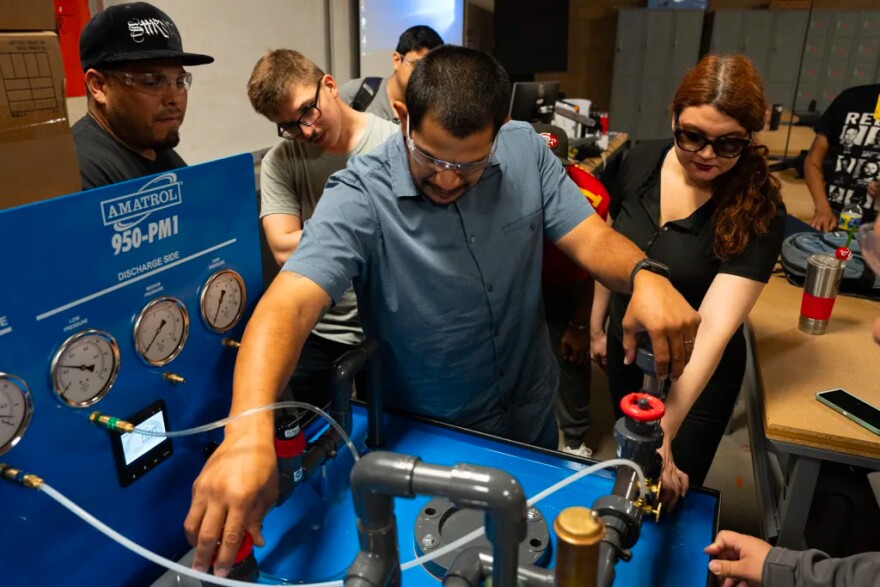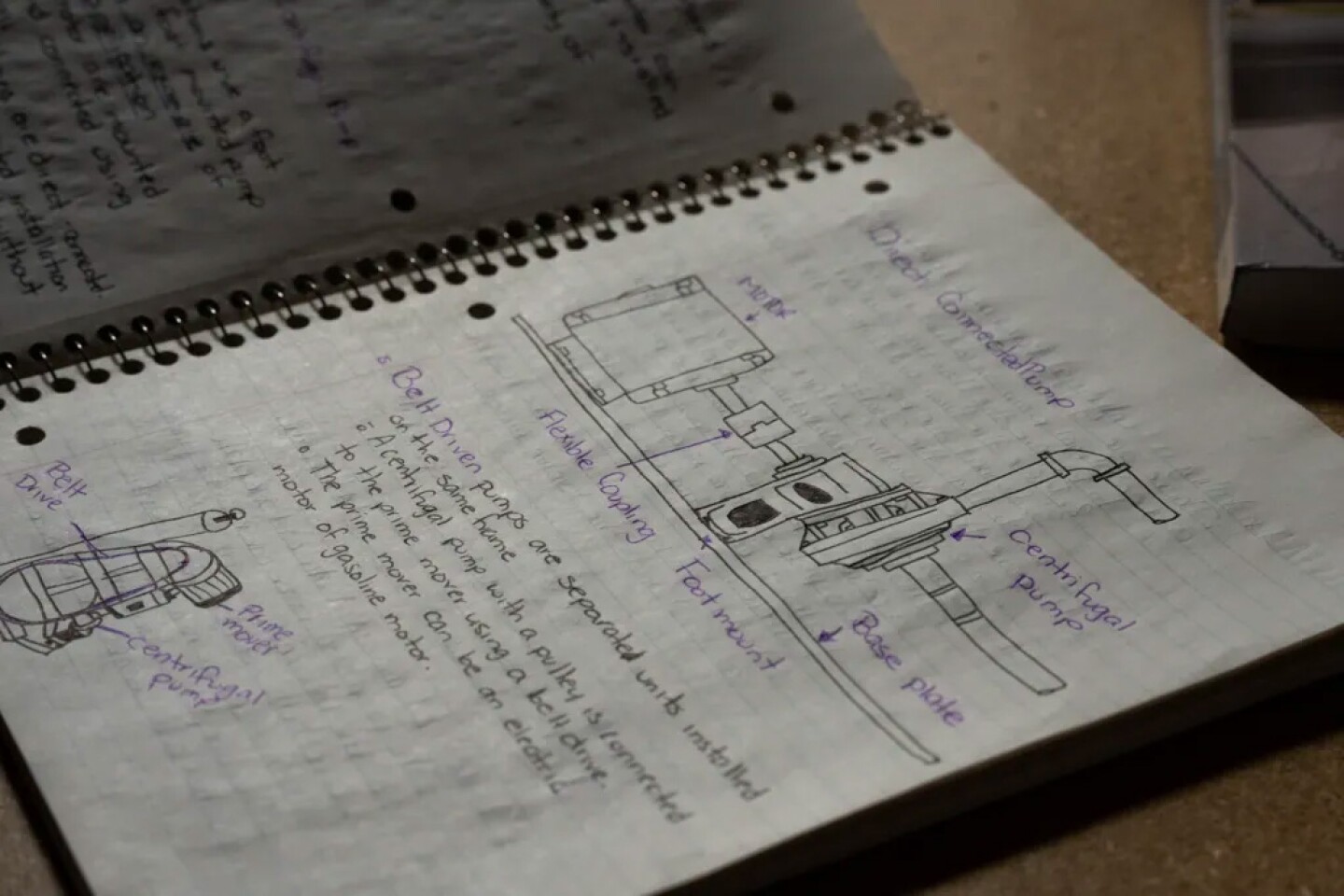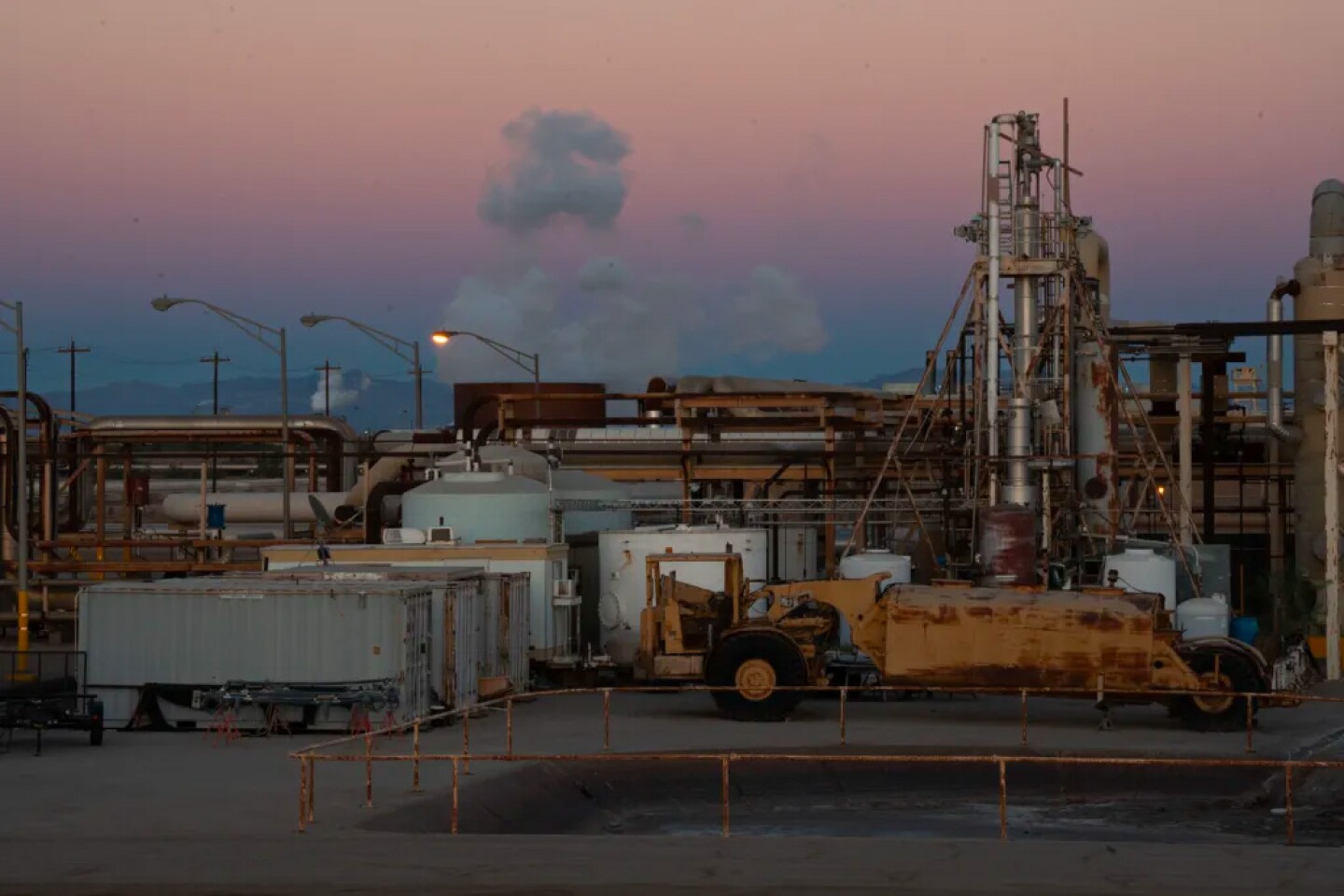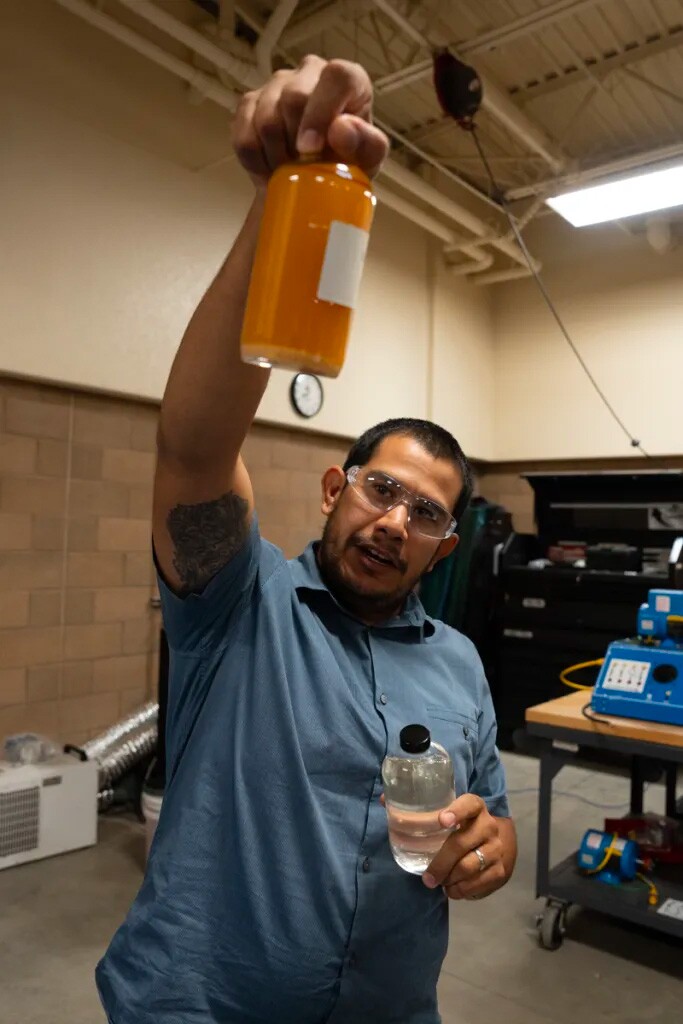Before Raul Flores held "white gold" in his fingertips, he'd tried his hand at other Imperial Valley jobs. He worked as a correction officer in the state prison, he grew medjool dates on ten acres of land and he eventually landed a job at the geothermal plants around the Salton Sea.
Then he got wind that under his feet lay enough lithium to supply roughly a third of the world’s demand, and he knew that was a game changer.
“Lithium equals future,” said Flores, holding a gleaming chunk of lithium chloride between his fingertips so his classmates could get a better look.
The crystal in his hands made concrete something that has eluded him and the other students, all part of Imperial Valley College's inaugural class of aspiring lithium industry workers:
The promise of a better future.
The 49ers football jersey Flores wore harkened back to another era when people pinned their hopes and dreams on minerals in the earth.
Could this be the next gold rush?
A key metal in batteries that power electric cars and computers, lithium has spiked in value over the last decade as global demand for the "white gold" has skyrocketed.
The massive, untapped repository in Imperial Valley – worth $500 billion by some estimates – could help make the United States a new – and key – player in the industry worldwide. That's because almost all of the world's supply is mined and refined abroad.
Chile sits on the majority of the world’s untapped reserves, mines in Australia provide more than half of the world’s supply, and China produces over half of the world’s batteries. The U.S. is barely on the chart.
In the Imperial Valley, companies running geothermal power plants on the Salton Sea have known for years that the brine they’ve been pumping from reservoirs deep in the ground contains lithium, but the technology to extract it and the demand haven’t existed until recently. Today, both exist. Almost.
EnergySource Minerals has greenlit its commercial lithium project ATLiS, aiming to start production by 2026, and Controlled Thermal Resources and CalEnergy, a subsidiary of Warren Buffett’s BHE Renewables, are racing to the starting line as well, each developing its own method for cost effective extraction.
With investment trickling in, momentum is building, but it’s still unclear when the promised results will materialize. Nevertheless, stakeholders in the Imperial Valley are getting ready to reap the benefits.
Efrain Silva, the Imperial Valley College’s dean of economic and workforce development, launched the certificate program to train students for jobs in the lithium industry on a bit of a wager. Will the industry kick-in by the time the first class graduates next spring? Having the key companies on speed dial and collaborating with them on the curriculum, Silva says he would not have started the program if the projection for jobs wasn’t there.

Another more recent player has also amped up hopes: Statevolt, a battery producer, has announced plans to build out a battery factory in the valley to be operational by 2025. The company says it will be one of the largest in the U.S.
Battery manufacturing would be a logical and beneficial industry to grow alongside lithium extraction in the valley, said Imperial County Supervisor Ryan E. Kelley. It would bring more jobs for locals to the region while also reducing the distance in the supply chain. Currently, the production line from mineral extraction to battery making often crosses several national boundaries.
“Why can't it be refined and turned into cathodes and anodes and batteries right here?” Kelley said.
Projections and international attention aside, not all community members of Imperial Valley see dollar signs and solutions.
It wouldn’t be the first time the valley has hosted an alternative energy venture that dashed hopes for transformative impacts. Solar and wind have come into the valley and neither has delivered an abundance of sustained jobs, let alone addressed the larger inequities locals experience.
Consider: Imperial County has the highest unemployment rate in California at almost 15%. The median household income is $49,000 – less than the state average by $35,000 – and more than a quarter of children live in poverty. The county also is an outlier when it comes to a number of health indicators, including high rates of diabetes, liver disease and drug-induced deaths. Doctors are also studying causes for high rates of pediatric asthma symptoms, especially for residents living closer to the Salton Sea.
Community leaders have pointed out that industry in the valley has a history of being largely extractive, producing large profit with little feeding back to the communities bearing the impact.
Why would it be different this time? The believe-it-when-we-see-it sentiment runs consistently through the towns of Imperial.
Reverend John Freeman, of the African Methodist Episcopal Chapel in El Centro, says he hopes that any company that is going to be exporting resources gives back to the community, especially to local youth.
“If they don't have any opportunities, they're gonna run from this place,” he said.
Much at stake in lithium’s development
But this time local stakeholders say all the right ingredients are in place, and that’s given them a sense of agency.
“I would say that we were just happy to be asked to go to the dance,” Supervisor Kelley said. “And now, we are actually being more selective about who we're going to dance with.”
That has meant knowing what’s at stake.
Based on current costs and estimates, Imperial County holds more than $500 billion in lithium, and demand is projected to grow fivefold by 2030.
Last year Governor Gavin Newsom declared that all new car sales in California will be zero-emission vehicles by 2035. With the potential of supplying a substantial portion of estimated global lithium needs, Imperial Valley could be sitting in a transformative position – so much so that some now refer to it as Lithium Valley.
Governor Gavin Newsom went so far as to call it the “Saudi Arabia of lithium.”
Major oil industry investors have since begun to funnel money to Imperial lithium ventures.
As companies race to develop cost effective and safe technology to turn brine into “white gold,” they do so amid questions of whether they – like many other ventures around the world – will do so at the expense of the local communities. Or will they mitigate environmental impacts and give back in jobs, potentially shaping a new narrative?


Open pit mining and harvesting lithium from evaporation pools use hazardous chemicals such as hydrochloric acid as well as an exorbitant amount of water, and have been known to deplete and contaminate groundwater, disrupt sensitive ecosystems and in turn harm local populations.
In Imperial Valley, some community members see lithium mining as potentially exacerbating the community's health problems, which endure while residents continue to grapple with environmental hazards stemming from the Salton Sea.
Trying to build local support, the lithium companies have held numerous public meetings where they discuss benefits they plan to give back to the community. They’re also explaining their “direct lithium extraction” methods, currently in development, and pitching them as safer to the environment.
The DLE process makes use of existing geothermal plants, which pump very hot brine to the surface to generate electricity and then pump the remaining brine back into the earth. DLE adds the step of mixing the brine with chemicals to extract the lithium, reducing the waste to something called filter cake.
Companies allege DLE is much less harmful to the environment, and it is, according to some preliminary studies. But with how new the technology is, long-term impacts are yet to be known.
Lithium dreams for locals
As Imperial Valley communities prepare for the lithium future there, the promise of jobs remains a shifting target, and fault lines and new alliances have emerged among local stakeholders.
Imperial Valley College President Lennor M. Johnson says the lithium industry’s development could trigger transformative growth not just in the industries that use lithium in manufacturing, but also in the expansion of jobs and services necessary to accommodate that growth. He sees housing, hotels, schools, entertainment centers and malls as part of that growth – all amenities that could make the Imperial Valley a place where younger people see a future for themselves.
“I can truly envision that Imperial County is going to look something like Temecula in the next five, ten years,” Johnson said, referring to the rural community north of San Diego that went through a similar transformation over the last several years. For Temecula it was the promise of affordable housing that expedited growth. For Imperial County, housing would be just one part of the equation.
“Lithium is one component,” Johnson said. “Expansion is going to be very necessary and crucial, which is going to just really put Imperial County on the map.”
Stakeholders, investors and community members have been discussing the viability of the industry in Imperial Valley for several years. Planning entities, such as the Lithium Valley Commission, were set up to facilitate conversation among the numerous interested and skeptical parties. The process has not been smooth.
For one, representation has been an issue. Both the Quechan Indian Tribe and the Torres Martinez Desert Cahuilla Indians raised numerous issues, including concerns over ancestral lands and being invited to the table later than others. And when community members and representatives suggested that lithium should be taxed and the funds be distributed to frontline communities, tensions flared between pro-tax and pro-industry interest groups.
Approved last year, the tax calls for producers to pay monthly in the hundreds of dollars per metric ton of extracted lithium, depending on the size of the operation. The money is slated for Salton Sea restoration projects, community projects at or around the sea and the counties impacted by lithium extraction.
How much communities will see is anyone’s guess – the money won’t be collected until commercial production begins. In one estimate, EnergySource Minerals CEO Eric Spomer said that over the next 30 years, the company alone anticipates delivering $720 million in taxes.
Eric Reyes and Isabel Solis of Los Amigos de la Comunidad are among the advocates insisting that communities impacted get their fair share.
“From the beginning the community has been very wary,” Reyes said. “People have come in to use our resources and made billions of dollars through the years, and our community stays generally poor.”
Investment in education locally has fueled hopes that the lithium industry will greatly benefit the community. The state gave $80 million alone to build a STEM building on San Diego State University’s Imperial Valley campus.
Imperial Valley College acted even faster, forging relationships with the lithium companies to create their certificate program. Silva aims to grow the program into IVC’s first ever bachelor’s degree, a particularly meaningful goal in a region with limited access to higher education. He also has additional lithium programs on his roadmap as demand grows.

The IVC program convinced students like Rose Fernandez to return to school despite it adding to her already full plate as a single mom of four children, working full time at EnergySource Minerals for minimum wage. She says she’s thankful for the job that she found through a temp agency, especially for the benefits, but it's still hard to make ends meet.
When EnergySource Minerals launches its commercial lithium operation, called ATLiS, Fernandez wants to be ready for opportunities that need her advanced skills and pay more.
“They’re going to be able to say, hey, I got my certificate,” Fernandez said. “I got education, and that’s what employers look for – education.”
Silva says he’s heard lithium could create up to 2,500 jobs in Imperial Valley, but thinks it may be less. Companies have their own estimates, which vary. ATLiS aims to have 71 new jobs at its lithium venture set to produce commercial lithium in 2026.
Spomer, the EnergySource Minerals CEO, told inewsource that they “‘anticipate a vast majority of the direct jobs created by ESM to be filled locally,” and that they expect to hire plant operators during construction.
Our class, Our Lithium
The plant operator’s class feels like the deck of a ship crewed by an eclectic and storied bunch, full of jokes and candor.
That may be in part due to the professor. It’s Rafael Serrano’s first time teaching but he has worked with pumps and engines since he joined the Navy at 19. Afterwards he worked for the Imperial Irrigation District as well as energy companies in the valley – when it comes to the trade, he doesn’t lack experience.

As for teaching, he said his wife told him “it's one of those things where there is no manual.” So Serrano gives ample room for the students to show up with all their character.
The class is learning how to safely and smoothly run a pump system. They learn on a miniature version of pump systems at the geothermal plants lining the Salton Sea. When the pump is on and it sounds like it's off, that’s one sign the students calibrated it right – no vibrations.
Serrano teaches two cohorts, a total of 59 students, including five women.
Fernandez is among the five and says there are opportunities for women in the field, but “they have to think that it’s not just for men.”
For the students, jobs in the lithium industry promise a new way of making ends meet and perhaps something that could significantly change their way of life.
A pest control specialist now studying lithium extraction, Dylan Charles has been leafing through books about lithium for years. He was taken aback when he started “hearing rumblings” about the valley having potential to drive U.S. domestic lithium production.
“That’s a huge development,” Charles said. “I don’t think a lot of people realize just how big that is.”
Wallace Phillips sees the industry as something that could hold families together. The retired El Centro traffic signal operator says his own children left the valley for lack of economic opportunity.
Phillips is hopeful for the future, but also holds on to his skepticism. When he saw two congressmen at a community meeting in nearby Calipatria, a community on the front-line of the geothermal plants, he thought “‘it's a little late.”
He went down the list of problems they should solve if they really mean to help, from access to healthcare to the toxic Salton Sea. Those problems didn’t emerge recently, he said.
Still, he turned bright the moment he looked back toward the model pump and recalled the feeling of when he and his classmates calibrated it to a silent hum.
“It’s great when you feel like you're part of something.”








